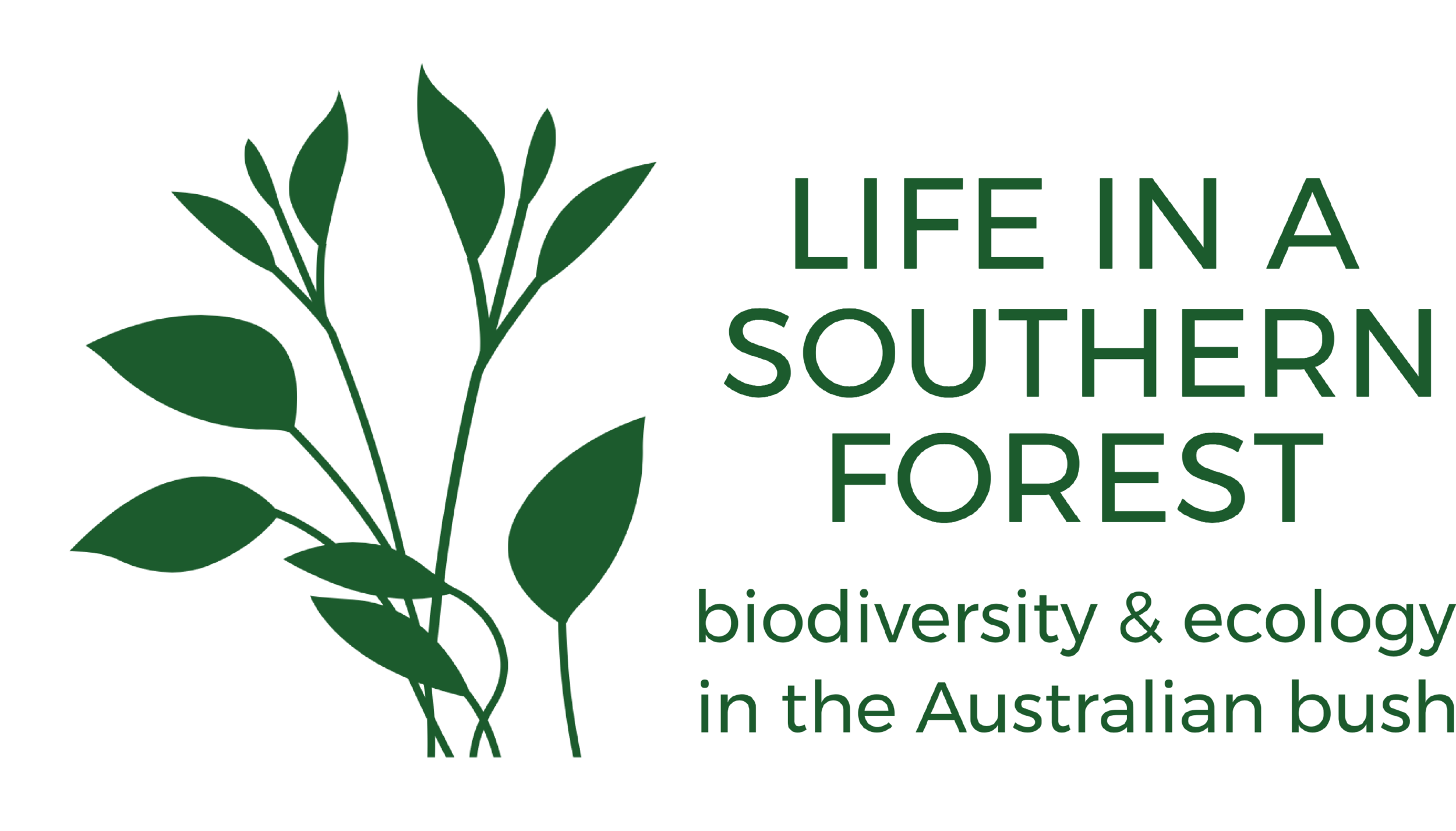
body length 4.7mm
antennae; 3 segmented, simple
whole thorax, abdomen bright metallic blue
all segments of all legs bright metallic blue laterally and dorsally, except joints between femora and tibiae orange
hind basitarsus longer than next 2 tarsal segments together

genae and face yellow-orange
tongue longer than head, dorsal side blackish
lateral side of head, thorax and abdomen unpunctured
tegula yellow

clypeus, labrum, inner orbits, orange
antennal flagellum shorter than closest distance between eyes
face, ventral side of thorax and abdomen unpunctured
ventral side of thorax and abdomen metallic blue, except for orange apical segment of abdomen
ventral and anterior side of all segments of all legs black, except for ventral side of fore tibiae which are orange
ventral side of tongue grey
pre-apical spur on mid and hind tibiae

flagellum of antenna shorter than distance between eyes, approx. same width as scape

antenna; scape black, pedicel and flagellum orange; flagellum single segment, approx. same thickness as scape
mandibles yellow with black tip
labrum and clypeus yellow
inner orbits and genae yellow
glossa (tongue) grey ventrally, black dorsally; almost as long as eye

pronotum, mesonotum and scutellum bright metallic blue, unpunctured
distance between hind ocelli greater than distance between an ocellus and back of head
antennal flagellum about same thickness as scape, shorter than distance between eyes
vertex black, genae orange

prosternum and mesosternum bright metallic blue, without punctures
genae, mandibles, labrum orange

abdomen viewed ventrally
abdomen shining with coarse transverse wrinkles
apical segment of abdomen yellow-orange

abdomen viewed dorsally after removal of wings
all terga bright metallic blue, except posterior tergum 1 pale orange, unpunctured

apical abdominal segment with ovipositor sheath viewed dorsally

lateral view of rear of abdomen, showing ovipositor sheath (third valvula) and protruding tip of saw (lancet or first valvula)
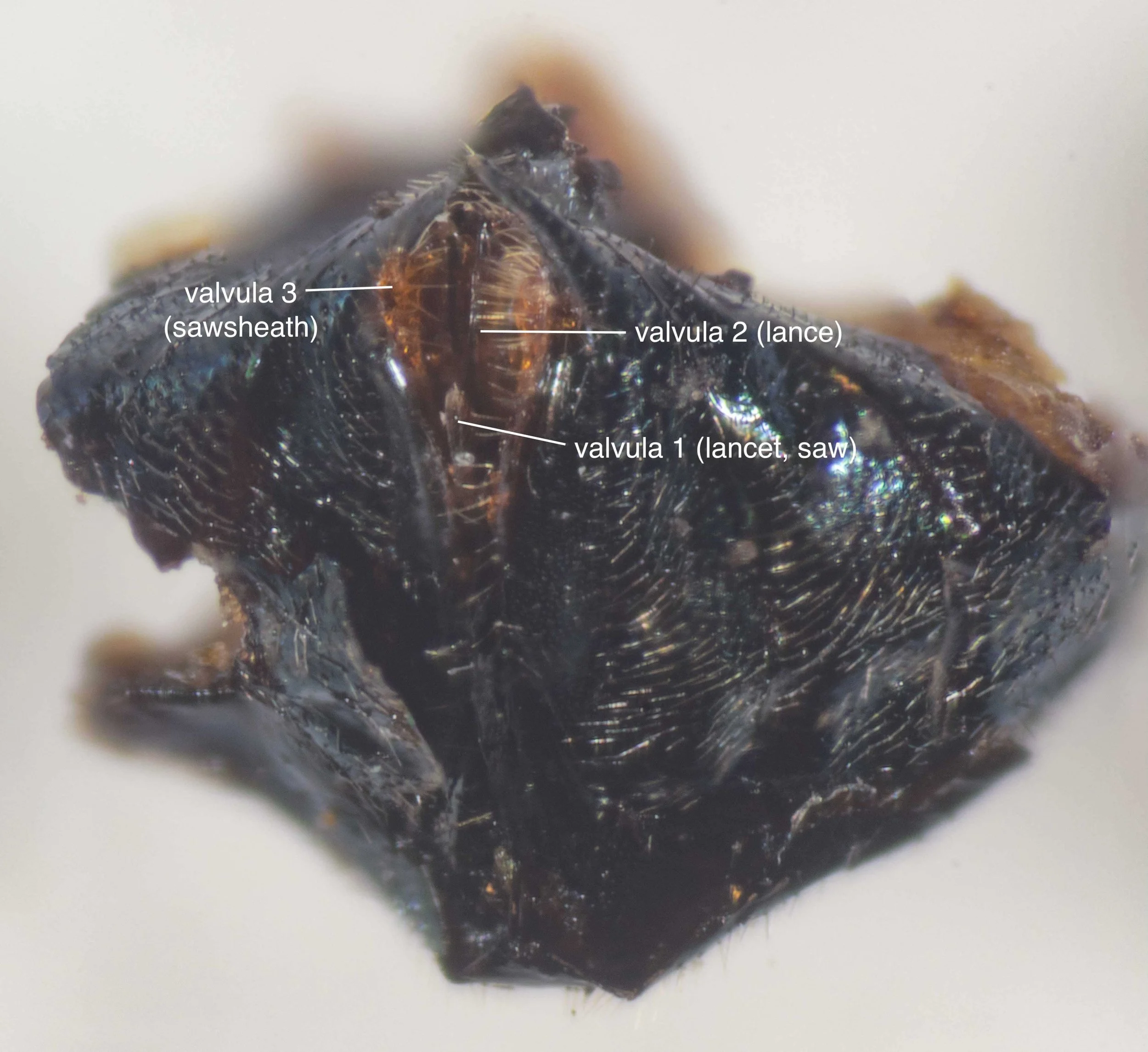
posterior view of end of abdomen showing ovipositor structures

apical tip of ovipositor sheath (third valvula) after removal from body, densely covered in stiff bristles

sawsheath and apex of abdomen in T. nitidus (9) and T. australis (10) - from Benson (1938), figs. 9, 10

portion of saw in T. nitidus (11), including teeth 8-12 of total 14 widely spaced teeth and T. australis (12), including teeth 8-16 of total of about 27 teeth, each bearing smaller denticulations - from Benson (1938), figs. 11, 12

saw (lancet or first valvula) dissected from female - with hair bands and 16 teeth, each bearing smaller denticulations (serrulae).
different number of teeth to T. australis and different to T. nitidus in possessing serrulae
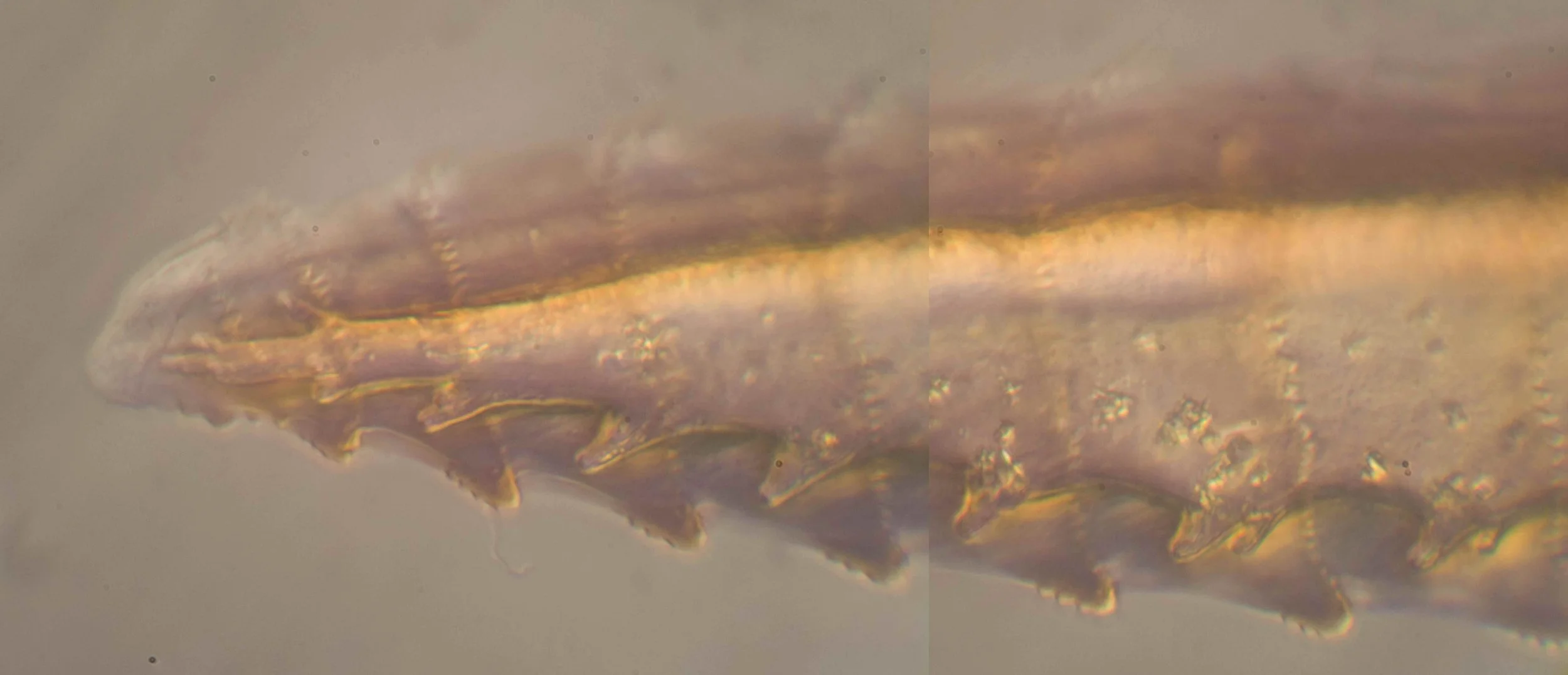
enlarged view of end of saw (lancet or first valvula) showing teeth 1-6, each with 3 small serrulae (denticulations)
Malagon-Aldana et al (2021) state that in the Trichorhachus sp. ovipositor examined (Fig. 27A,B) serrulae were absent.

distal 2/3rd of saw (lancet)
saw is similar to T. australis but has fewer teeth (16 vs. 27)
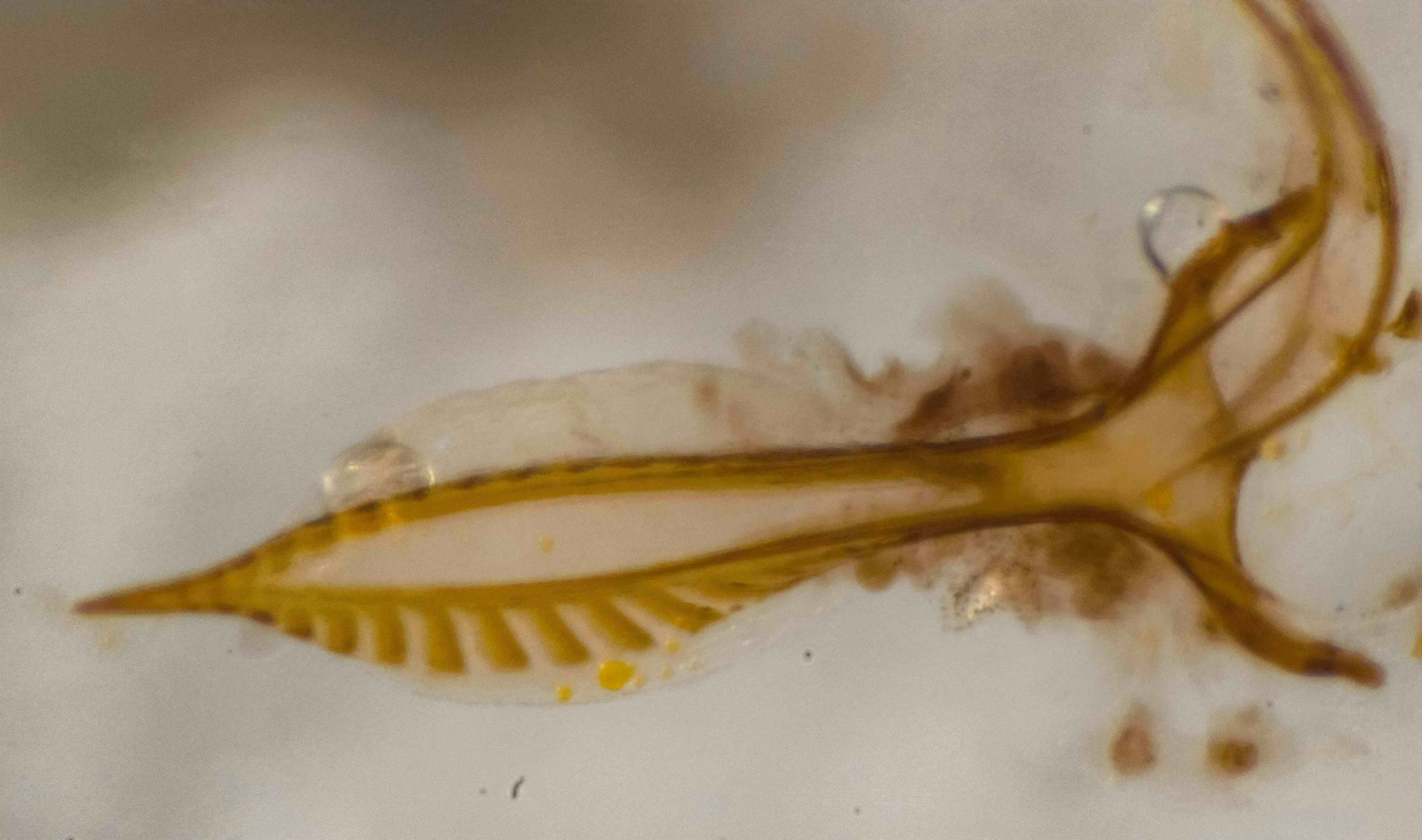
lance (second valvula) dissected from body

lance (second valvula) dissected from body

forewing RHS
hyaline; stigma and venation black; basal vein joins subcosta at a distance from the cubitus almost as great as the length of the 1st transverse cubital vein

hind wing RHS
hyaline, stigma and venation black

forewing LHS
hyaline; stigma and venation black; basal vein joins subcosta at a distance from the cubitus almost as great as the length of the 1st transverse cubital vein

hind leg - all segments black

mid leg - all segments black, tibia with preapical spur

fore leg - tibia orange on ventral surface, all other segments black

fore leg - tibia orange on ventral surface, all other segments black

body length 5.0mm
antennae: 3 segmented, simple; scape black, pedicel and flagellum orange
antennal flagellum longer than closest distance between eyes
flagellum slightly narrower than scape
ventral side of thorax and abdomen bright metallic blue
genae, labrum, mandibles orange (latter with black tips)
legs: all coxae and femora black, all tibiae and tarsi orange-blackish

genae orange, vertex black
proboscis shorter than head, galea relatively short
lateral side of thorax, mesonotum, scutellum and abdomen metallic blue; tegula blackish-orange
legs: all coxae and femora black, except hind femora black basal half, orange apical half dorsally; all tibiae and tarsi orange

antenna black scape, orange pedicel and flagellum (with apex blackened), thinner than scape
genae orange, black vertex
pronotum black medially, orange laterally
mesoscutum, scutellum bright metallic blue, unpunctured
stigma brown, venation dark brown
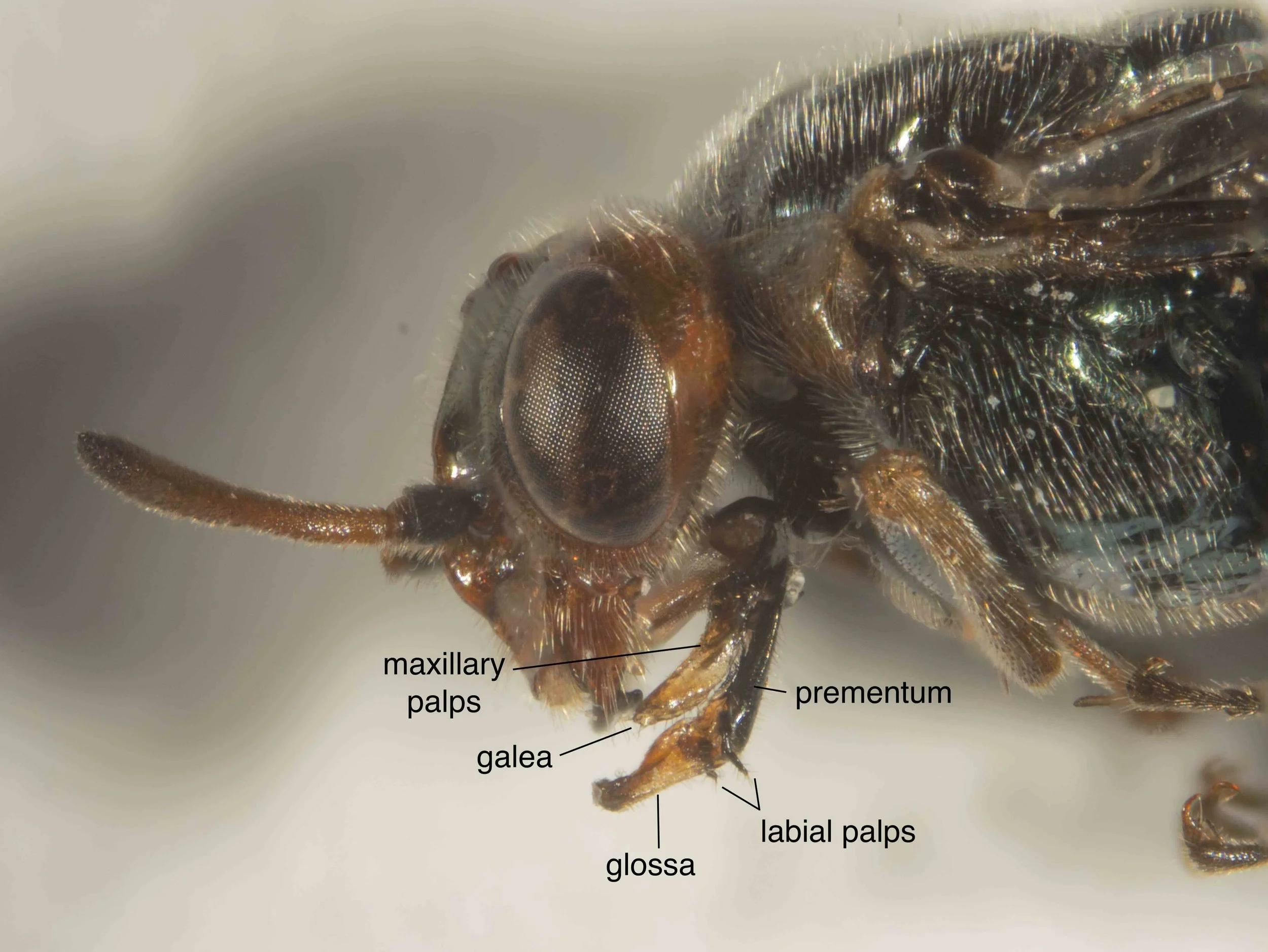
parts of proboscis shown:
- glossa (tongue), labial palps and prementum parts of labium; glossa shorter than prementum, much shorter than length of eye
- galea and maxillary palps parts of maxilla
antennal flagellum slightly narrower than scape at greatest width

parts of proboscis shown:
- glossa (tongue), labial palps and prementum parts of labium; glossa shorter than prementum, much shorter than eye length
- galea and maxillary palps parts of maxilla
genae, vertex orange; post-ocellar area black
frons black

genae, vertex orange; post-ocellar area black
pronotum orange with black dorsal patch
tegula brownish-orange
mesopleura, mesoscutum and scutellum black

genae, inner orbits, clypeus, labrum, mandibles orange (tips of latter black)
frons black
pronotum orange with black dorsal patch

genae, inner orbits, clypeus, labrum, mandibles orange (tips of latter black)
frons black
pronotum orange with black dorsal patch
tegula orange
mesopleura shiny metallic blue, unpunctured

genae, vertex orange; post-ocellar area black
distance between ocelli greater than distance between ocellus and back of head
mesoscutum shiny metallic blue, unpunctured

genae, inner orbits, clypeus, mandibles orange (latter with black tips)
forelegs - coxa, femur black; distal femur, tibia and tarsomeres orange; distal tarsomeres black

frons, post-ocellar area black; inner orbits, clypeus, labrum, vertex orange
ocelli mounted on elevated platform

abdomen shiny metallic blue laterally
venation brown

abdomen viewed laterally
shiny metallic blue, unpunctured
cerci, 10th abdominal segment orange
sawsheath (3rd valvula) black, laterally flattened, not bifid cf. fig. 9 from Benson (1938)
tip of projecting saw visible - orange

lateral view of apex of abdomen
sawsheath laterally flattened, black; not bifid at apex, cf. fig. 9 from Benson (1938)
projecting saw visible, orange

apex of abdomen viewed dorso-laterally
cerci, 10th abdominal segment orange
sawsheath (3rd valvula) black, laterally flattened, not bifid cf. fig. 9 from Benson (1938)
tip of projecting saw visible - orange

sawsheath and apex of abdomen in T. nitidus (9) and T. australis (10) - from Benson (1938), figs. 9, 10

abdomen viewed from rear after removal from female and treatment with KOH to separate sclerites
saw, sawsheath, 10th tergum with attached cerci, 9th and 8th terga visible
same as photograph of T. nitidus ovipositor in Fig. 24F, Malagon-Aldana et al (2021) - see Reference images below

sawsheath viewed laterally after dissection from body

lancet (saw) dissected from female; with ~16 teeth, cf. fig. 11 from Benson (1938) which shows teeth 8-12
very similar to 1st valvula (lancet) in Fig. 27A of Malagon-Aldana et al (2021) which shows ~16 teeth - see Reference figures below

lancet (saw) dissected from female; with 16 teeth (#15, 16 faint), cf. fig. 11 from Benson (1938) which shows teeth 8-12
very similar to 1st valvula (lancet) in Fig. 27A of Malagon-Aldana et al (2021) which shows ~16 teeth - see Reference figures below
serrulae (denticles) absent on teeth - listed by Malagon-Aldana as a character state of ovipositor of Trichorhachus sp.

portion of saw in T. nitidus (11), including teeth 8-12 of total 14 widely spaced teeth and T. australis (12), including teeth 8-16 of total of about 27 teeth, each bearing smaller denticulations - from Benson (1938), figs. 11, 12

saw (lancet) dissected from female, separated from lance

lance dissected from female, lancet separated

dorsal view of wings: hyaline, stigma and venation brown

left forewing: hyaline, stigma and venation brown
identical venation to Trichorhachus sp. wing in Fig. 17A, Malagon-Aldana (2021) - see Reference images below

left hind wing; hyaline, venation brown
identical venation to Trichorhachus sp. wing in Fig. 17A, Malagon-Aldana (2021) - see Reference images below
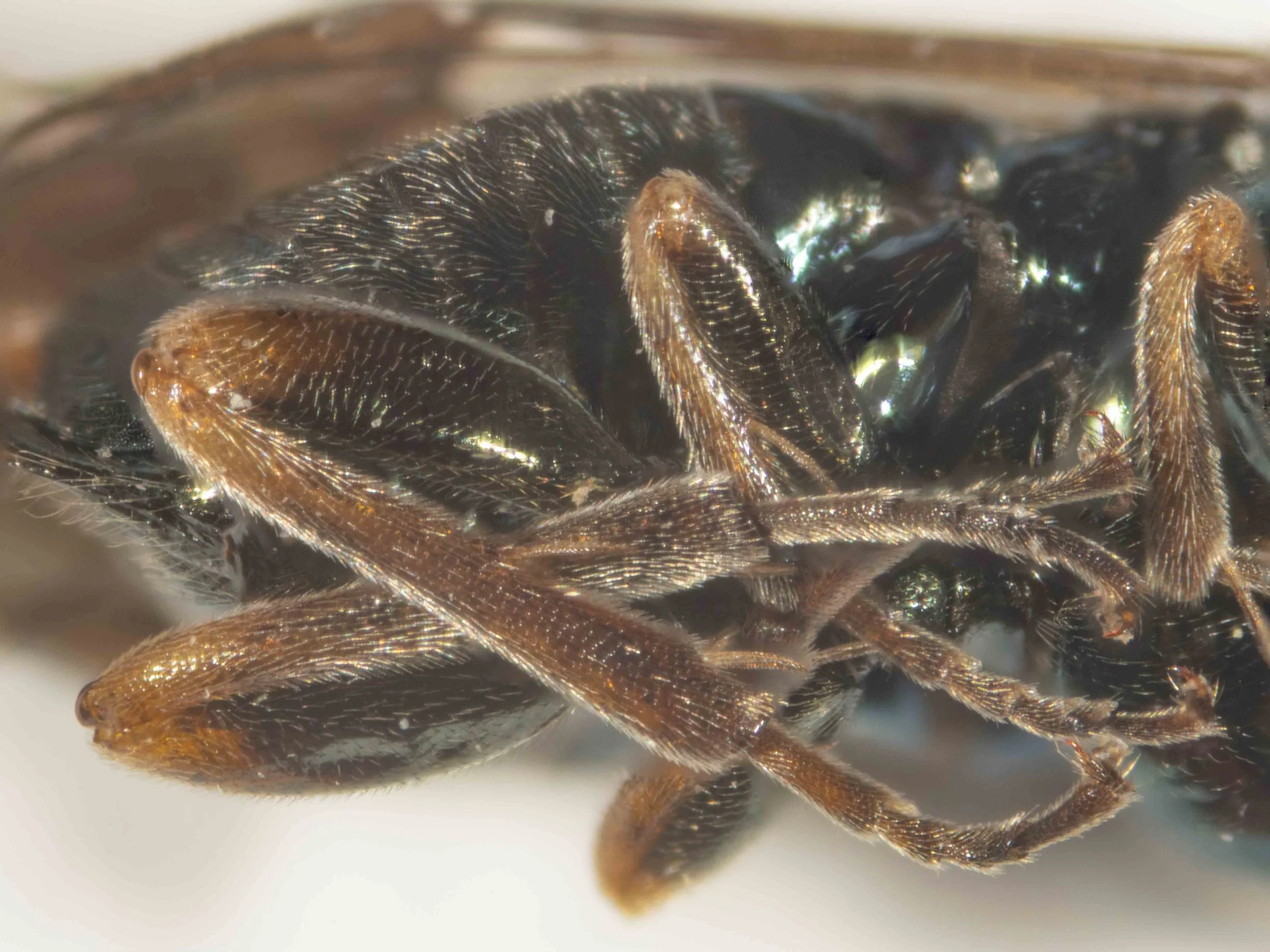
ventral view of body
mesopleura, mesosternum and venter shiny metallic blue, unpunctured
coxae and femora of all legs shiny metallic blue, distal tip of fore femur orange; tibiae and tarsi of all legs orange with distal tips of tarsal segments black
hind basitarsus long than following two tarsal segments; preapical spines on mid and hind tibiae

hind legs dissected from female (left tibia and tarsus missing); coxae and femora black; apical femur, tibia and tarsi orange; apex of tarsomeres blackish

forelegs (LHS) and mid legs (RHS) removed from female (tarsi missing from mid legs)
- all femora black with apical tip orange, all tibiae and tarsi orange

body length 5.5mm
antennae: 3 segmented, simple; scape black, pedicel and flagellum orange
antennal flagellum slightly longer than closest distance between eyes
flagellum slightly narrower than scape
genae orange, vertex orange, post-ocellar region and frons black
lateral side of thorax, mesonotum, scutellum and abdomen metallic blue
legs: all coxae and femora black, except apical ¼ hind femur orange; all tibiae and tarsi orange, tarsomeres darkened

pronotum orange posteriorly, black anteriorly
genae orange clypeus, labrum, mandibles orange (latter with black tips)
tegula blackish-orange
wings hyaline; costa, stigma and venation brown

glossa pale yellow with speckled black tip, shorter than black prementum, labial palps black

glossa pale yellow with speckled black tip, shorter than black prementum, labial palps black, maxillary palps black
pronotum orange ventrally and laterally

abdomen shiny metallic black; sawsheath black, flattened; lancet orange; cerci orange

ventral view of terminal abdominal segments, showing flattened saw sheath

pronotum black and orange
tegula brownish-orange
mesopleura black
legs: coxae and femora black, tibiae and tarsi orange with some blackening of distal tibia on forelegs

abdomen shiny metallic blue laterally
legs: mid and hind femora black, apical 1/3rd hind femur blackish-orange

antennae: scape black, pedicel orange, flagellum orange with blackish tip
genae, vertex orange; post-ocellar area black
distance between ocelli greater than distance between ocellus and back of head
mesopleura shiny metallic blue, scape blackish-orange

distance between hind ocelli greater than distance between ocellus and back of head
genae, vertex orange; post-ocellar area black
pronotum orange speckled with black dorsally

mesonotum, scutellum bright metallic blue
pronotum black anteriorly and dorsally, orange posteriorly
tegula orange, speckled with black
wings hyaline, brown venation

thorax and abdomen shiny metallic blue, T1 with pale yellow stripe in posterior half
saw sheath black, orange distally
cerci orange
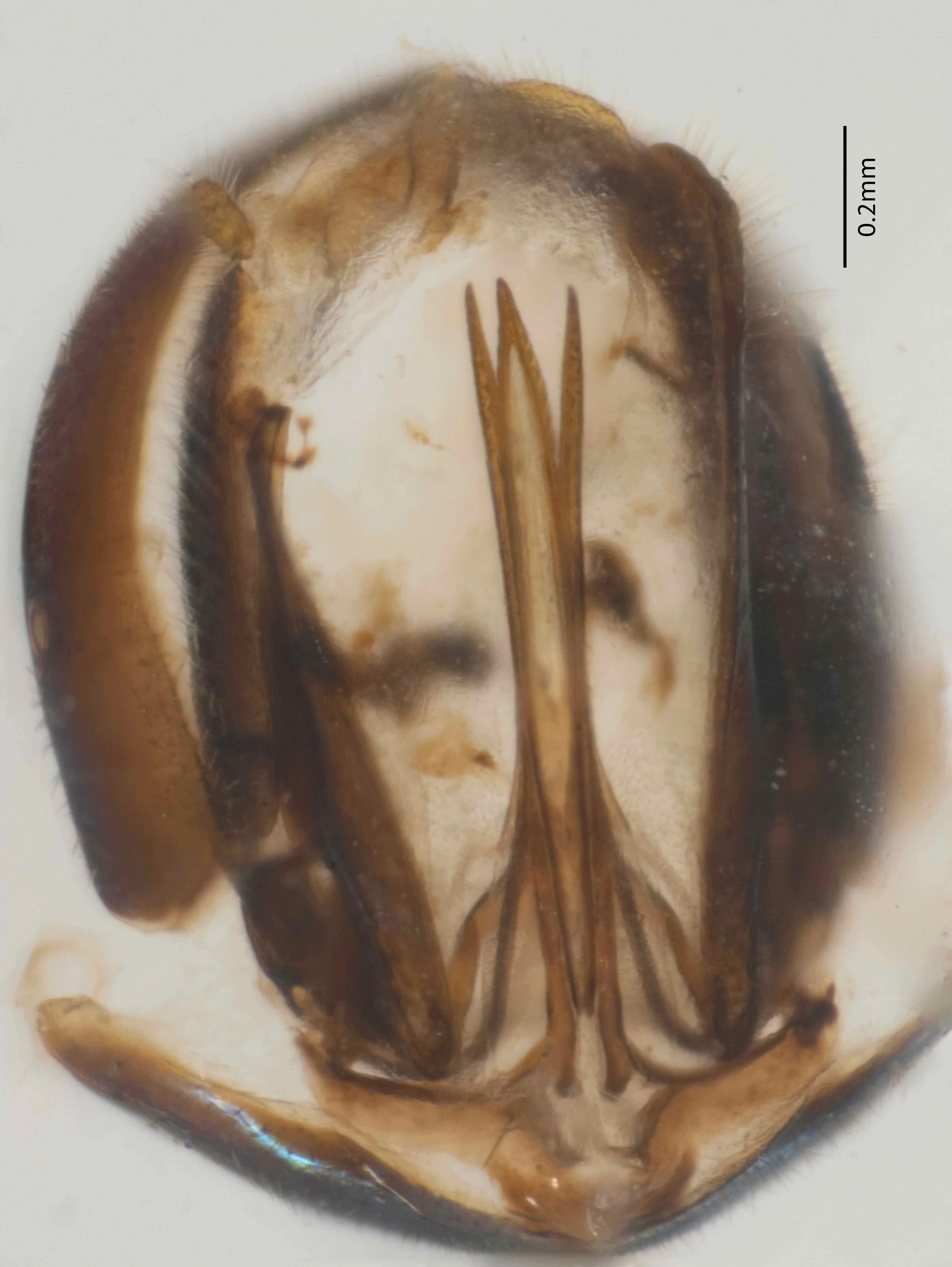
abdomen viewed from rear after removal from female and treatment with KOH to separate sclerites
lancet, lance, sawsheath and 10th tergum with attached cerci, 9th tergum visible
identical to photograph of T. nitidus genitalia in Malagon-Aldana et al (2021), Fig. 24F (cf. Warradarge PW055)
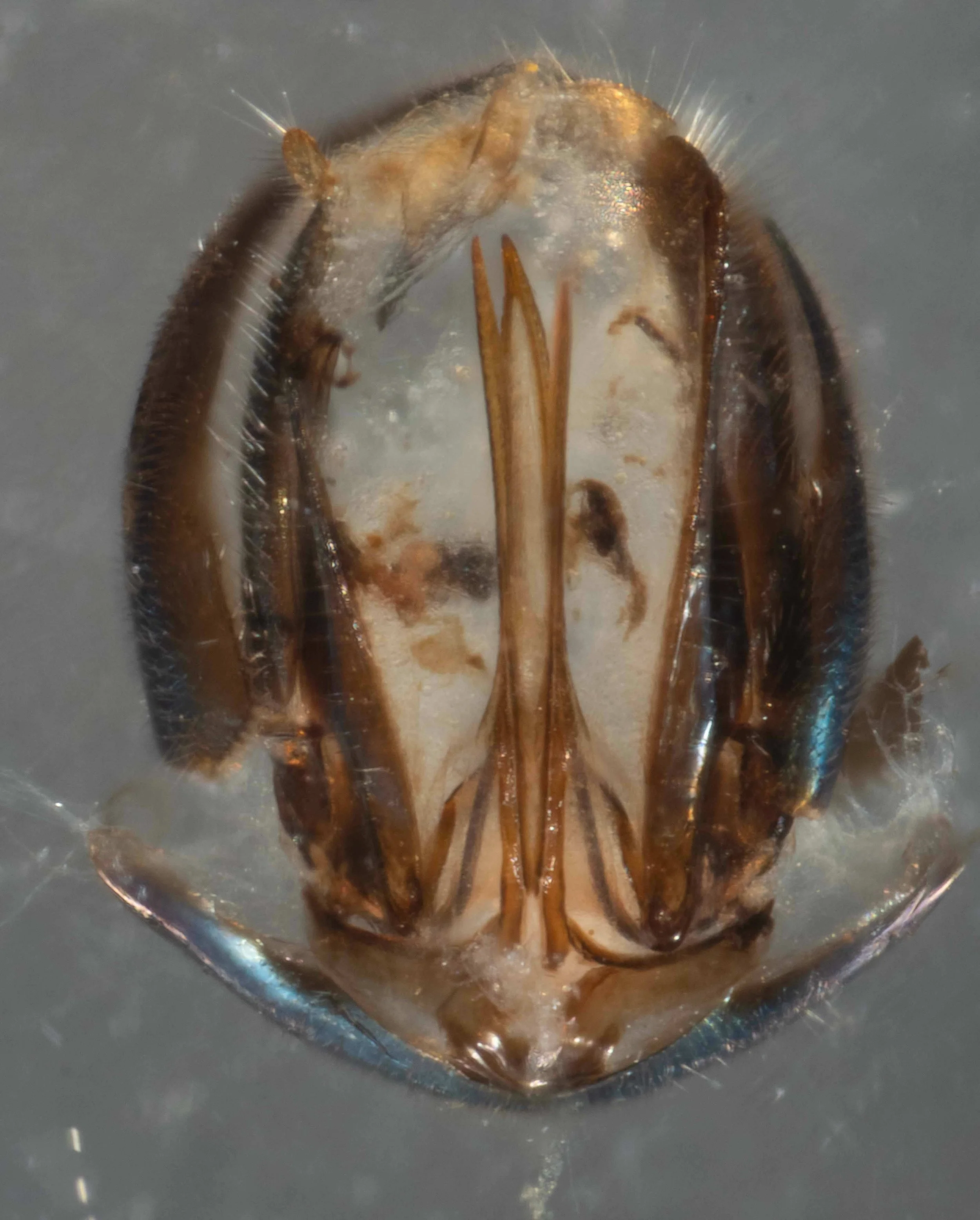
abdomen viewed from rear after removal from female and treatment with KOH to separate sclerites
lancet, lance, sawsheath and 10th tergum with attached cerci, 9th tergum visible
identical to photograph of T. nitidus genitalia in Malagon-Aldana et al (2021), Fig. 24F (cf. Warradarge PW055)

thorax and abdomen bright metallic blue ventrally
legs: all coxae and femora black, with distal apex of hind femur orange; all tibiae and tarsi orange, hind tibiae darkened

saw sheath (valvula 3, damaged on RHS) and lance (valvula 2)

sawsheath (valvula 3) viewed laterally after dissection from body. cf. Warradarge PW055

lancet (valvula 1)

lancet (valvula 1)

lancet - 12 teeth, first 3 with serrulae

lancet, first 9 teeth - serrulae on first 2-3 teeth

other side of lancet - 11 teeth, first 8 with serrulae

forewing: costa, stigma and venation brown

hind wing: hyaline, costa and venation brown
















































































